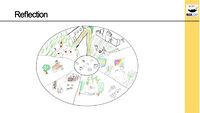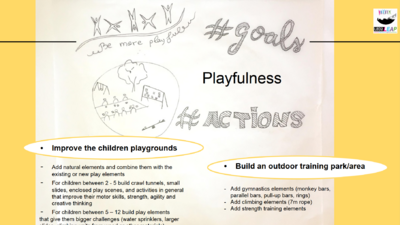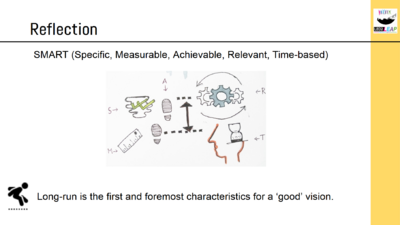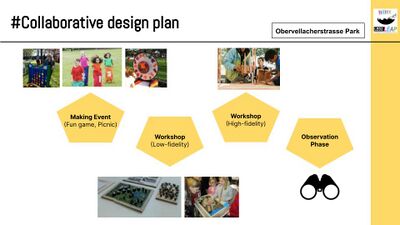LED2LEAP 2020 - Freising Team 7: Difference between revisions
Sonja.weert (talk | contribs) |
Sonja.weert (talk | contribs) |
||
| Line 216: | Line 216: | ||
== The Evolution of Your Prototyping Action == | == The Evolution of Your Prototyping Action == | ||
*''Describe the actors who were working together on this action. What was your collaborative design process? What tools or methods did you use to collaborate?'' | *''Describe the actors who were working together on this action. What was your collaborative design process? What tools or methods did you use to collaborate?'' | ||
For this intervention we mainly aimed for kids, because they are probably the most important target audience. We also invited their relatives and students to help them. | |||
1. Community Event - making the action known to the community | |||
2. Low fidelity workshop - selection of the actions to take in the park, preliminary design ideas | |||
3. HIgh fidelity workshop - | |||
4. Observation - feedback for further design proces | |||
<gallery caption=" " widths="400px" heights="300px" perrow="3"> | <gallery caption=" " widths="400px" heights="300px" perrow="3"> | ||
Revision as of 15:36, 29 June 2020
>>>back to working groups overview
| Area | Freising | |
| Place | Freising | |
| Country | Germany | |
| Topics | Landscape democracy / health and well-being / blue-green infrastructure | |
| Author(s) | Farhana Afroze, Sonja De Weert, Noorjahan Begum, Bogdan Drăghici | |

| ||
Landscape Democracy Rationale
The landscape is part of the community, as is the community part of the landscape. The community lives in the landscape, but is also shaped by it. Changes on either of them will also affect the other. Therefore it is important to include the people who live here in planning processes, so that they have a voice through active participation in its protection, conserving and maintaining it as best as they can.
Location and scope
Freising - Munich Airport community
Location
Freising is located north of the Bavarian capital Munich, Germany.
Characteristics
- plain, with hills in the north (Domberg and Weihenstephaner Berg)
- the rivers Isar, Moosach and Amper
- mainly arable lands, moorlands and forests
- Munich international airport
Socio-economical
- 48.000 inhabitants (546/km2 (2018)
- Strong developed education system
- Important religious presence
- City full of young people (16.4% below 17 years, lot of students)
- Strong economy (mainly trade, traffic and services; only 1% in agriculture)
- Good community transition (from a rather rural area to an important business location)
- Low unemployment rate (more than 4000 enterprises, largest continuous hop-growing site in the world)
- Many investors and developers
Groups of actors and stakeholders present here
- Key actors :Individuals, Authorities, Heath care system, Airport, Communication (mobility)
- Primary groups: Farmers, Environment protection, Recreation, Education, Environmental protection associations, Commerce, Industry
- Secondary groups: Churches, Cultural groups, Elders, Ethnic groups, People with disabilities, Energy, Investors & Developers, Tourism
The Freising community includes different social groups and stakeholders like local and external. Social groups are children, students, individuals, senior citizens, differently able people, churches, different ethnic groups, and also many cultural communities. Additionally, education, agriculture, health care, restaurants, tourism, leisure-time and relaxation, small-big business groups, industries, Munich airport plays the local stakeholder role. There are some external stakeholders influences also exist from communications, forestry, authorities, developers, recycling, energy sectors, and water protection sectors, etc. All groups are either directly or indirectly connected with each other.
Regarding the landscape demands the Freising community needs some aspirations. For instance, the community requires better and clear recreation spaces, improved traffic connections (more parking places or ringway), innercity bike path connections, and also needs more public open spaces.
Relationships between your actors and groups
Authorities have the executive power (over individuals) due to the voted laws. On the other hand if individuals, when united in mind and body, they can create a voice that can influence the authorities. Industry is also an important factor of influence due to its economic impact/control, because it's creating jobs, and provides a better way of living for people.
The tourism, agriculture, authority and recycling communities have in common environmental protection. The other way around, the farmers and environmental protection share the same space, but have other interests and goals.
Summary of your learnings from the transnational discussion panel on April 22
Via the panel we had a look on how the other groups used the framework. It was interesting to see that they sometimes had another analytical approach or used a different way of visualizing. That broadened our horizon and gave us inspiration.
We also received some very useful feedback on how to further develop our community map to a higher level.
Theory reflection
- Storytelling, a model of and a model for planning
From the Storytelling, a model of and a model for planning we have learned regarding the process of how to develop ideas on storytelling in planning practice. It represents how a good story can help to overcome a critical situation of planning to reach in the desired ending as well as connect present not only to make sense of the past but also to prepare for the future through the stories.
- EU Directive on public access to environmental information
The directive shows that the EU has eye for the public and its interest in the landscape, but you could say that it is a bit vage and it leaves too much to the member states. There also seems to be not in control on what degree the member states implement this. Furthermore it mainly speaks about how public participants have access to the general landscape information, rejecting a proposal,... but never mentions the community as an active participant in a design (cfr. Ladder of Participation).
- Council of Europe
According to the European Landscape Convention, the public's active participation is prior to protect the heritage value of the landscape. Additionally, the mutuality between local inhabitants and the professionals is also key factors for identifying and assessing landscape features.
References
- https://www.kreis-freising.de/
- http://www.citypopulation.de/php/germany-bayern.php?cityid=09178124
- https://www.toytowngermany.com/wiki/Freising
- https://www.freising.de/media/user_upload/61_Stadtplanung_Umwelt/6110_pdf-Files/STEP/stadtteilsteckbrief-suedwest.pdf
- https://www.bavaria.by/visit/freising/
- https://en.wikipedia.org/wiki/Freising
- https://www.salaryexpert.com/cost-of-living/germany/freising
Phase B: Democratic Landscape Analysis and Assessment
The Scene in your Story of Analysis
- The main character of the story is Gunter Roeder, who is 72 years old retired engineer. Mr. Roeder went out to do food groceries from his neighboring store and meet shopkeeper Ataturk Ganja. From informal chitchat with Mr. Ganja, he found the same pale feelings that he has about his community's park and green spaces. He found out similar in thoughts when he meets with two students in the park. The grandchildren of Mr. Roeder are also involved in the story. His thoughts also become more attached when he got the same grey feelings from his grandchildren. After all those meetings with other persons from different groups, the person has a strong realization about the less motivating playgrounds, parks, and green spaces in the community. Altogether they initiated some surveys and workshops to fix the exact landscape democracy challenge of the community and to address the common solutions for all.
- As it will be seen below, our landscape democracy challenge is the fact that the playgrounds & green spaces in Freising are not suitable enough in the matter of people's needs. Firstly playgrounds are there but they don't show any variety and we also find them serious and strict, instead of motivating children to find creative ways of playing they provide a limited amount of directions to play and secondly, regarding the recreational areas for adults, they are very conservative and outdated, no outdoor training's parks (calisthenics) '
The Actors in your Story of Analysis
- The main actors of the story are kids, students, senior citizens, differently-abled people, different ethnicity and also from authority. There are some direct and indirect relationships between them. The family-based relationship and the social relationship, both are visible in between those groups. Normaly the autorities have a large influence, but they are here less important and remain more passive.
The Story of Analysis
- We want to make the people dream about their own community. The 1st method will help to dream and get information from actors especially to know the landscape better. Then they will make different opinions from their individual perspectives. Different visions next to each other might indicate different solutions and sometimes one solution for one is doesn't suit others. But they have to work together for a solution to find out it at least at a satisfactory level for all.
- 2nd method will be used to make awareness about their own neighborhood landscape. They can out for look into their known neighborhood in a new potential way. They can take pictures, videos and they can interact with people from the community to know their community from a closer perspective.
- With the 3rd method we want to allow everyone to generate his own ideas to find solutions through the collaboration of all aged groups. We gather ideas with surveys, interviews, mapping workshops, or just some post-its on a wall. They then can discuss in the group all the different ideas and rank them. This way we avoid domination of the more vocal participants and all voices can be heard.
Reflect on your Story of Analysis
- They fitted very well. The purpose of workshops, surveys and "city recon" helped the actors interact better with each other and their landscape, made them more aware about their needs and power of implementing them, the weaker voices got their chance to speak up and share their ideas, willingly to take part in the community design process and feel more attached to their neighborhoods.
- The tools help to minimize the conflict of opinion variation from individuals. Additionally, those tools lead to making a common ground of problems and solutions.
Phase C: Collaborative Visioning and Goal Setting
The Scene in your Story of Visioning
- Our democracy challenge still remains, the sadness and lack of applicability for specific users in the Freising community (out of date playgrounds and lack of outdoor training facilities for students), put in other words the lack of playfulness met in the green spaces, instead of making people feel better and more active it bores them to death. The people that we interviewed had mainly the same complain, that their children don’t wish anymore to go to the parks because it’s too boring and regarding the older actors (student), they were just simply disappointed that in such a great and active city there are no solutions when it comes to outdoor gymnastics training.
The Actors in your Story of Visioning
- Joining the old actors who pointed out the main challenge are the following, the mayor, which situates himself at the top due to his presence and influence in the city, then followed by Eva Senden-Lorenzo (the best designer in Freising, self-intitled) and Mark Bonig, our random crafty and handy builder, able to build everything it’s thrown at him with the most precise of work. Bogdan Draghici and Sonja De Weert our trusty landscape architects put everyone together for a meeting in one of the children’s parks from Freising, to be more exact the one on Obervellacherstrasse. There they discussed different aspects of the current green and park situation in the community, they came up with ideas and agreed on common goals as playfulness, safety, social involvement, nature and age targeting.
The Story of Visioning
We are introducing some actions to achieving the goals, for example, improve the children's playgrounds for children between 2-5 and 5-12 years old and build an outdoor training park as well as design Obervellacherstrasse Park as an exciting place which invites the different aged group people. Here can promote natural elements and combine them with the existing or new playing equipment. For the age group of 2-5 years, introduce some activities like crawl tunnels, small slides, enclosed play scene, sand play, and puzzle walls which can encourage learning through play there and going to foster spatial skills that are important for later skills development and playing with natural environments allows children to learn with all of their senses. For the children between 5-12, build water sprinkles, larger slides, climbing units from wood or other materials. Also, We can add gymnastic elements, for example, monkey bars, parallel bars, pull-up bars, ring, and climbing or strength training elements improving body and still a lot of fun to use.
- In total five phases, the process will run towards the final construction phase. The three-year action plan will begin with the meeting with authority and consultation which will take the first half-year. In the second half of the year, the decision will make for starting the planning process. Overall planning processes and temporary solutions will need approx one full year. After two years, six months time needs for final approval, and announce a tender invitation. In the last six months of the three years action plan, time will be spent on selecting a feasible proposal from builders and finalizing the building contract.
Reflect on your Story of Visioning
- When formulating goals it is important to consider SMART (Specific, Measurable, Achievable, Relevant, Time-based) goals. SMART goals help to get structured and organized paths reaching the target.
- Long-run is the first and fore-most characteristics for a ‘good’ vision.
Phase D: Collaborative Design, Transformation and Planning
Your Prototyping Action
In prototyping action plan, the most important part is to let the community have an Active Part in designing their own park and playground. The participation process takes some time before it is realized, so in this way they will also catch a first glimp of the future park/playground.
Phase C helps for the evaluation of intervention stages in the preliminary action plan process. We're building further on the knowledge we acquired during previous meetings with the community.
The Evolution of Your Prototyping Action
- Describe the actors who were working together on this action. What was your collaborative design process? What tools or methods did you use to collaborate?
For this intervention we mainly aimed for kids, because they are probably the most important target audience. We also invited their relatives and students to help them.
1. Community Event - making the action known to the community 2. Low fidelity workshop - selection of the actions to take in the park, preliminary design ideas 3. HIgh fidelity workshop - 4. Observation - feedback for further design proces
The Plan Behind Your Prototyping Action
- What resources, material and human, did you need to realize your action, and how were they used? What roles were created for this action? Additionally, What kind of timeframe was created for executing the plan?
We need to connect the community, surroundings schools for cooperation with the action and authority because the park is situated in public ground. The resources of this action are materials and humans. Materials are including pallets, poles etc. which will be provided by companies who are agreed to work with this action. Human participation like kids from gymnasium and kindergarten to shape the park &playground, also the students from Fachoberschule u. Berufsoberschule (Technical school) as the action can be a part of their school project to help the kids for making new and predesign elements. It can be taken half a day to build the prototype.
We have made an action plan for three years. The plan will start with the meeting with authority and introduce some community events. After six months, we will arrange some low and high fidelity workshops to come up with a solution that takes two years. In the last year of three years’ timeline, the design process of the park will begin and get the final approval, and then the construction phase will start which takes six months. All of these steps will complete within three years.
The Realization of Your Prototyping Action
- What happened, who was there and what was the atmosphere like among the participants?
- add the corresponding visual from your presentation to the image gallery below
Reflect on Your Prototyping Action
- In the end, what change did the intervention create? How would you adjust it to be more effective if you did it again? Consider what it means to be successful, what indicators would you use to measure success in this endeavor? Most importantly, how did your intervention reflect the material in the Phase D lectures?
- add the corresponding visual from your presentation to the image gallery below
Phase E: Collaborative Design, Transformation and Planning
* template coming
= Phase E: Collaborative Evaluation and Future Agendas * template coming
Process Reflection
- Reflect in your intercultural and interdisciplinary team on the outcomes of your study
- Which limitations were you facing?
- What have you learnt from each other?
- What would you do differently next time?
- You can also use diagrams/visuals
- 250 words text
All in all the work done until now by our team, gave us a better understanding of our position in the community and our power to change and influence it. And for sure it made us realize that as active participants in the community or given the chance to some of us becoming specialists, elected representatives or technical staff of local, regional and national authorities, we have a great responsibility towards the present and future well-being of the whole society. And we also realized this aspect that the landscape related issues are not affecting just one part of the community/society but the whole and that there should be a much better communication between all actors.
































